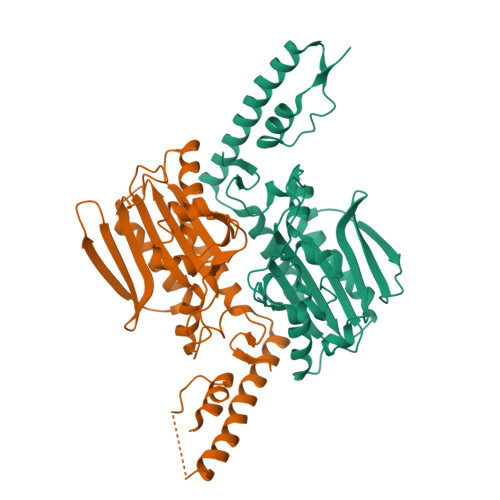Crystal Structure of Pyrrolysyl-tRNA Synthetase from a Methanogenic Archaeon ISO4-G1 and Its Structure-Based Engineering for Highly-Productive Cell-Free Genetic Code Expansion with Non-Canonical Amino Acids.
Yanagisawa, T., Seki, E., Tanabe, H., Fujii, Y., Sakamoto, K., Yokoyama, S.(2023) Int J Mol Sci 24
- PubMed: 37047230
- DOI: https://doi.org/10.3390/ijms24076256
- Primary Citation of Related Structures:
8IFJ - PubMed Abstract:
Pairs of pyrrolysyl-tRNA synthetase (PylRS) and tRNA Pyl from Methanosarcina mazei and Methanosarcina barkeri are widely used for site-specific incorporations of non-canonical amino acids into proteins (genetic code expansion). Previously, we achieved full productivity of cell-free protein synthesis for bulky non-canonical amino acids, including N ε -(((( E )-cyclooct-2-en-1-yl)oxy)carbonyl)-L-lysine (TCO*Lys), by using Methanomethylophilus alvus PylRS with structure-based mutations in and around the amino acid binding pocket (first-layer and second-layer mutations, respectively). Recently, the PylRS·tRNA Pyl pair from a methanogenic archaeon ISO4-G1 was used for genetic code expansion. In the present study, we determined the crystal structure of the methanogenic archaeon ISO4-G1 PylRS (ISO4-G1 PylRS) and compared it with those of structure-known PylRSs. Based on the ISO4-G1 PylRS structure, we attempted the site-specific incorporation of N ε -( p -ethynylbenzyloxycarbonyl)-L-lysine ( p EtZLys) into proteins, but it was much less efficient than that of TCO*Lys with M. alvus PylRS mutants. Thus, the first-layer mutations (Y125A and M128L) of ISO4-G1 PylRS, with no additional second-layer mutations, increased the protein productivity with p EtZLys up to 57 ± 8% of that with TCO*Lys at high enzyme concentrations in the cell-free protein synthesis.
Organizational Affiliation:
RIKEN Center for Biosystems Dynamics Research, 1-7-22 Suehiro-Cho, Tsurumi, Yokohama 230-0045, Japan.




















